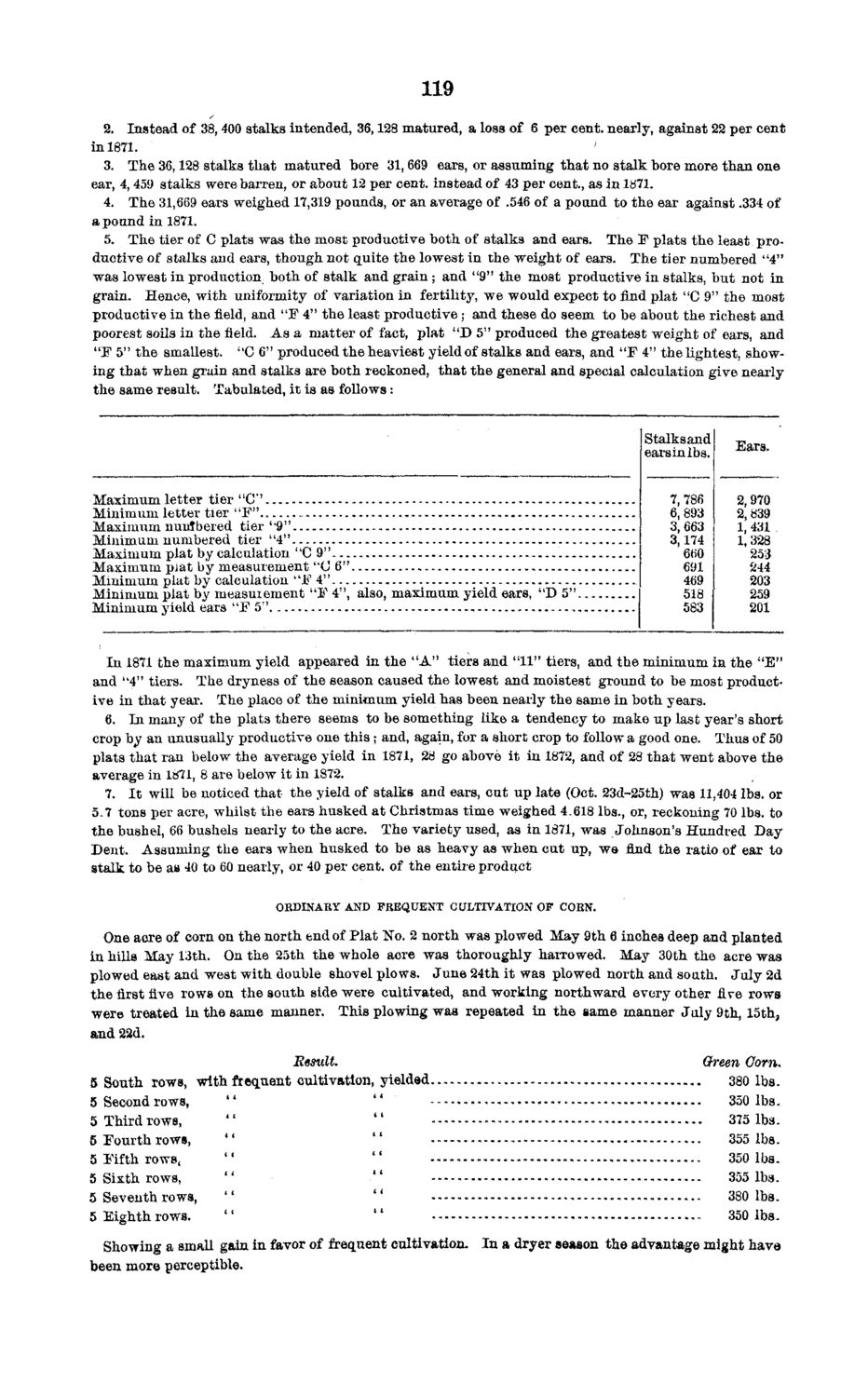| |
| |
Caption: Board of Trustees Minutes - 1873
This is a reduced-resolution page image for fast online browsing.

EXTRACTED TEXT FROM PAGE:
119 2. Instead of 38,400 stalks intended, 36,128 matured, a loss of 6 per cent, nearly, against 22 per cent in 1871. ' 3. The 36,128 stalks that matured bore 31,669 ears, or assuming that no stalk bore more than one ear, 4, 459 stalks were barren, or about 12 per cent, instead of 43 per cent., as in 1871. 4. The 31,669 ears weighed 17,319 pounds, or an average of .546 of a pound to the ear against .334 of a pound in 1871. 5. The tier of C plats was the most productive both of stalks and ears. The F plats the least productive of stalks and ears, though not quite the lowest in the weight of ears. The tier numbered "4" was lowest in production both of stalk and grain ; and "9" the most productive in stalks, but not in grain. Hence, with uniformity of variation in fertility, we would expect to find plat "C 9" the most productive in the field, and " F 4" the least productive; and these do seem to be about the richest and poorest soils in the field. As a matter of fact, plat "D 5" produced the greatest weight of ears, and "F 5" the smallest. "C 6" produced the heaviest yield of stalks and ears, and "F 4" the lightest, showing that when grain and stalks are both reckoned, that the general and special calculation give nearly the same result. Tabulated, it is as follows: Stalks and earsinlbs. Maximum letter tier "C"' Minimum letter tier " F " 1 Maximum nuntbered tier '9" Minimum numbered tier "4" Maximum plat by calculation "C 9" Maximum plat by measurement "C 6" Minimum plat by calculation "Jf 4" Minimum plat by measurement "F 4", also, maximum yield ears, "D 5' Minimum yield ears "F 5 : ' 7,786 6,893 3,663 3,174 660 691 469 518 583 Ears. 2,970 2,839 1, 431 1,328 253 244 203 259 201 In 1871 the maximum yield appeared in the "A" tiers and "11" tiers, and the minimum in the "E" and "4" tiers. The dryness of the season caused the lowest and moistest ground to be most productive in that year. The place of the minimum yield has been nearly the same in both years. 6. In many of the plats there seems to be something like a tendency to make up last year's short crop by an unusually productive one this; and, again, for a short crop to follow a good one. Thus of 50 plats that ran below the average yield in 1871, 28 go above it in 1872, and of 28 that went above the average in 1871, 8 are below it in 1872. 7. I t will be noticed that the yield of stalks and ears, cut up late (Oct. 23d-25th) was 11,404 lbs. or 5.7 tons per acre, whilst the ears husked at Christmas time weighed 4.618 lbs., or, reckoning 70 lbs. to the bushel, 66 bushels nearly to the acre. The variety used, as in 1871, was Johnson's Hundred Day Dent. Assuming the ears when husked to be as heavy as when cut up, we find the ratio of ear to stalk to be as 40 to 60 nearly, or 40 per cent, of the entire product ORDINARY AND FREQUENT CULTIVATION OF CORN. One acre of corn on the north end of Plat No. 2 north was plowed May 9th 6 inches deep and planted in hills May 13th. On the 25th the whole acre was thoroughly harrowed. May 30th the acre was plowed east and west with double shovel plows. June 24th it was plowed north and south. July 2d the first five rows on the south side were cultivated, and working northward every other five rows were treated in the same manner. This plowing was repeated in the same manner July 9th, 15th, and 22d. 5 5 5 5 5 5 5 5 Result. South rows, with frequent cultivation, yielded " " Second rows, Third rows, Fourth rows, Fifth rows, " Sixth rows, Seventh rows, Eighth rows. Green Corn. 380 lbs. 350 lbs. 375 lbs 355lbs 350 lbs 355 lbs 380 lbs 350 lbs Showing a small gain in favor of frequent cultivation. In a dryer season the advantage might have been more perceptible.
| |